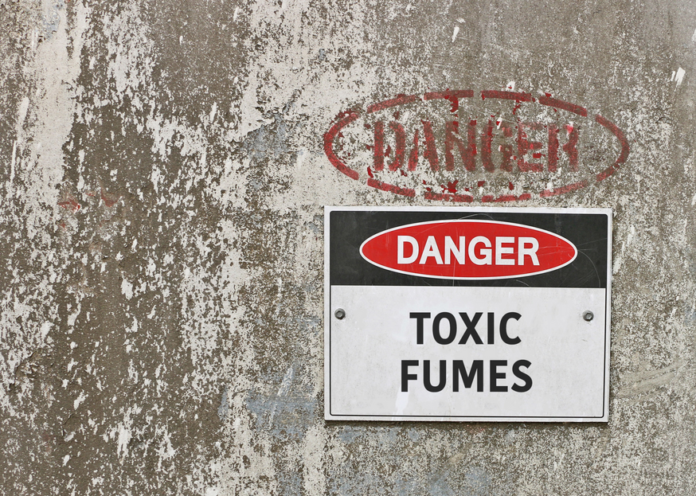In 2018, there were about 2.8 million non-fatal workplace injuries and illnesses in the United States. While many of these injuries and illnesses are caused by physical hazards, such as slips, trips, and falls, a significant number are also caused by chemical hazards.
So, what exactly is a chemical hazard? A chemical hazard is any substance that has the potential to cause harm to an individual’s health. This can include both liquids and gases, and exposure can occur through inhalation, skin contact, or ingestion.
In this blog post, we’ll outline seven common chemical hazards in the workplace. By familiarizing yourself with these hazards, you can help boost workplace safety for yourself and your colleagues.
1. Asphyxiants
An asphyxiant is a chemical hazard that can cause suffocation by displacing oxygen in the air. Inhalation of asphyxiants can lead to dizziness, nausea, and ultimately unconsciousness.
One common type of asphyxiant is carbon dioxide, which is released during welding and other industrial processes. Another type of asphyxiant is nitrogen, which is found in compressed air tanks.
With proper ventilation, asphyxiants can be safely used in workplaces. However, without adequate ventilation, they can pose a serious health hazard.
If you suspect that you or someone else has been exposed to an asphyxiant, seek medical attention immediately. Inhalation of asphyxiants can be extremely dangerous and even fatal.
2. Corrosives
Corrosives are one of the most dangerous types of chemical hazards found in workplaces. These substances can cause severe chemical burns to the skin and eyes. If ingested, they can even be fatal.
Corrosives are often found in cleaning products, acids, and other industrial chemicals. It is essential that workers take precautions when handling these materials. Always wear protective clothing, such as gloves and goggles, and be sure to work in a well-ventilated area.
In addition, you should know the first aid procedures in case of accidental exposure. In the event of a spill, immediately evacuate the area and notify the appropriate authorities.
3. Irritants
Irritants are substances that can cause inflammation of the skin, eyes, throat, lungs, and mucous membranes. They can be in the form of dust, mists, vapors, or gases.
Some common irritants include chlorine, ammonia, and sulfur dioxide. Irritants can enter the body through the skin, eyes, or lungs.
Short-term exposure to irritants can cause watering of the eyes, headache, coughing, and difficulty breathing. Long-term exposure can lead to permanent damage to the respiratory tract and even death.
Wearing personal protective equipment such as gloves, goggles, and masks can help to reduce your risk of exposure. If you work with irritants regularly, be sure to have regular medical checkups to monitor your health.
4. Sensitizers
Sensitizers cause allergic reactions in the body. When people are exposed to sensitizers, their bodies produce antibodies that make them more sensitive to the chemical. This can cause a range of symptoms, from mild skin irritation to life-threatening anaphylactic shock.
Sensitizers are commonly found in factories, construction sites, and hair salons. Some common sensitizers include latex, epoxy resins, and certain metals. Exposure to sensitizers can occur through inhalation, skin contact, or ingestion.
In some cases, people may not have any symptoms after their first exposure to a sensitizer. However, subsequent exposures can cause increasingly severe reactions and lead to serious workplace injury.
5. Carcinogens
Carcinogens are chemicals that can cause cancer.
Some carcinogens occur naturally, such as ultraviolet radiation from the sun. Others are man-made, such as asbestos fibers and tobacco smoke. Carcinogens can also be found in many workplaces, such as factories that use chemicals or materials that release carcinogens into the air.
Carcinogens damage DNA. The body’s’ cells usually repair this damage, but sometimes they cannot. The damaged cells then divide without control and form tumors.
Some cancers can be cured, but others are fatal. There is no sure way to prevent all cancers, but avoiding exposure to carcinogens is the best way to reduce your risk of cancer. Be especially keen when storing chemicals that can cause cancer.
6. Reactive Substances
Reactive substances readily undergo a chemical reaction with other substances. This means that they are highly unstable and can pose a serious hazard to workers if not properly handled.
Reactive substances come in many different forms. For example, they may be found as liquids, gases, or solids. They may also be in the form of dust or powders.
Regardless of their form, all reactive substances share one thing in common: they are extremely dangerous to human health. Exposure to reactive substances can cause serious health problems, including skin and eye irritation, difficulty breathing, and even death.
As such, it is essential that workers take care to avoid contact with these materials. When working with reactive substances, always wear proper PPE and follow all safety precautions, including maintaining proper chemical inventory lists.
7. Flammables
Flammables are chemicals that can easily ignite and cause a fire. They are often used in solvents, cleaning agents, and fuels. While they are essential for many industrial processes, they can also be extremely dangerous.
Flammables should always be stored in well-ventilated areas, away from heat or sparks. In the event of a fire, flammables can quickly spread the blaze and put workers at risk.
Any area where flammables are used should have an adequate fire suppression system in place. By applying chemical safety tips, however, flammables can be safely handled and pose minimal risk to workers.
Handle Common Chemical Hazards in the Workplace Safely
Chemicals are an essential part of many workplaces. While they can be dangerous, there are many ways to protect workers from the hazards they pose. By understanding common chemical hazards in the workplace and taking proper precautions, you can keep your workplace safe for everyone.
Did you enjoy this article? Keep visiting our blog for more exciting content.










